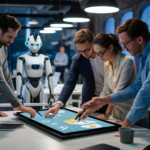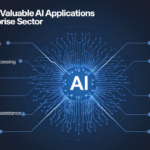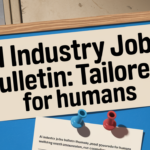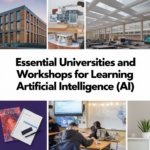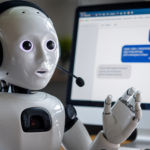The integration of artificial intelligence (“AI”) in the workplace is revolutionizing how we work by augmenting human capabilities, automating routine tasks, and enhancing decision-making and collaboration. As AI adoption accelerates, it is driving innovation, personalizing learning experiences, and optimizing workflows, thereby reshaping job roles and emphasizing the need for continuous upskilling.
AI is rapidly augmenting human capabilities across various industries and job functions, enhancing productivity, creativity, and decision-making. Here are some key ways AI is empowering human workers:
Cognitive augmentation:
AI systems can process and analyze vast amounts of data to provide insights and recommendations, augmenting human intelligence and decision-making capabilities. You can upload information into CHATGPT or Claude Anthropic and see the results immediately. For example, data scientists and business analysts use AI-driven analytics tools to uncover patterns and trends that were previously hidden in large datasets.
Also, AI algorithms can evaluate multiple scenarios and outcomes, helping executives make more informed strategic decisions. In finance, AI-driven predictive models assist in investment decisions by analyzing market trends and economic indicators.
Automation of routine tasks:
By taking over repetitive and time-consuming tasks, AI frees up human workers to focus on higher-value activities that require creativity, emotional intelligence, and strategic thinking. For example, in accounting, AI can automate data entry and invoice processing, allowing accountants to focus on financial planning and analysis.
Also, robotic process automation (RPA) uses AI to automate routine business processes, such as payroll processing and employee onboarding, significantly reducing the time and effort required for these tasks.
Enhanced creativity:
AI tools like CHATGPT and DALL-E are being used to generate ideas, suggest novel combinations, and provide inspiration for creative work in writing, visual arts, and design. Writers use AI to overcome writer’s block by generating story prompts or plot ideas.
AI-powered platforms enable creative professionals to collaborate more effectively by providing real-time feedback and suggestions. In music, AI can compose melodies that artists can then refine and develop. For example, UDIO and SUNO are two popular AI apps that generate quality music tracks from nothing more than a simple text prompt.
Personalized assistance:
AI-powered digital assistants can help workers manage their schedules, prioritize tasks, and provide relevant information contextually.[1] This personalized assistance improves efficiency and helps workers stay organized. Examples include AI tools like Microsoft’s Cortana and Google Assistant.
Digital assistants can provide contextual information and reminders, ensuring that employees have the information they need at their fingertips, which is particularly useful in customer service and sales roles.
Skill enhancement:
AI-driven learning platforms offer personalized training and development opportunities, helping workers continuously upskill and adapt to changing job requirements.[2] These platforms analyze individual learning patterns to provide customized content that addresses specific skill gaps.
AI can identify emerging skills required in the workforce and recommend relevant training programs, ensuring that employees remain competitive in their fields.
Physical Augmentation
In industries like manufacturing and healthcare, AI-powered robotics and exoskeletons are enhancing human physical capabilities, and improving safety and efficiency.[3] These technologies assist workers in performing tasks that require strength, precision, or endurance.
AI-driven robotics can perform hazardous tasks, reducing the risk of injury to human workers. In construction, AI-powered drones can inspect hard-to-reach areas, ensuring safety compliance without putting workers at risk.
Language translation:
Natural Language Processing (NLP) technologies are breaking down language barriers in global workplaces, facilitating seamless communication across diverse teams.[4] Real-time translation services enable better collaboration among multinational teams.
AI translation tools enable employees from different cultural backgrounds to work together more effectively, enhancing global business operations.
Predictive maintenance:
In industrial settings, AI systems can predict equipment failures before they occur, allowing human workers to proactively address issues and minimize downtime.[5] This predictive maintenance helps in reducing costs and increasing operational efficiency.
Predictive maintenance optimizes the use of resources by ensuring that maintenance activities are performed only when necessary, extending the life of equipment and reducing operational costs.
Enhanced Customer Service
AI chatbots and virtual assistants are augmenting human customer service representatives, handling routine inquiries and allowing humans to focus on more complex customer issues.[6] This improves response times and customer satisfaction.
AI-powered customer service solutions provide 24/7 support, ensuring that customers receive assistance at any time, which enhances the overall customer experience.
Data-driven insights
AI analytics tools are providing workers with real-time insights and data visualizations, enabling more informed decision-making across various business functions.[7] These tools help in identifying trends, forecasting outcomes, and optimizing strategies.
AI enhances business intelligence by integrating data from multiple sources and providing comprehensive insights that drive strategic decisions.
The strategic relationship between AI and human workers is creating a new paradigm in the workplace. AI’s ability to augment human capabilities and automate routine tasks is freeing up time for workers to engage in more meaningful and strategic activities. As AI continues to evolve, it will play an increasingly critical role in shaping the future of work, emphasizing the importance of continuous learning and adaptation. Embracing AI’s potential will enable organizations to thrive in a rapidly changing business landscape and empower their workforce to achieve greater heights.
By integrating AI into the workforce, companies can unlock new levels of productivity, creativity, and innovation. This collaborative intelligence between humans and AI is driving transformation across industries, reshaping job roles, and creating new opportunities for growth and development. As AI continues to advance, its impact on the workplace will only grow, highlighting the importance of embracing this technology to stay competitive in the modern economy.
Footnotes:
[1] https://explodingtopics.com/blog/ai-trends
[2] https://www.techtarget.com/searchenterpriseai/tip/9-top-AI-and-machine-learning-trends
[3] https://finance.yahoo.com/news/42-2024-artificial-intelligence-ai-160000486.html
[5] https://www.sciencedaily.com/news/computers_math/artificial_intelligence/
[7] https://www.ibm.com/blog/artificial-intelligence-trends/

